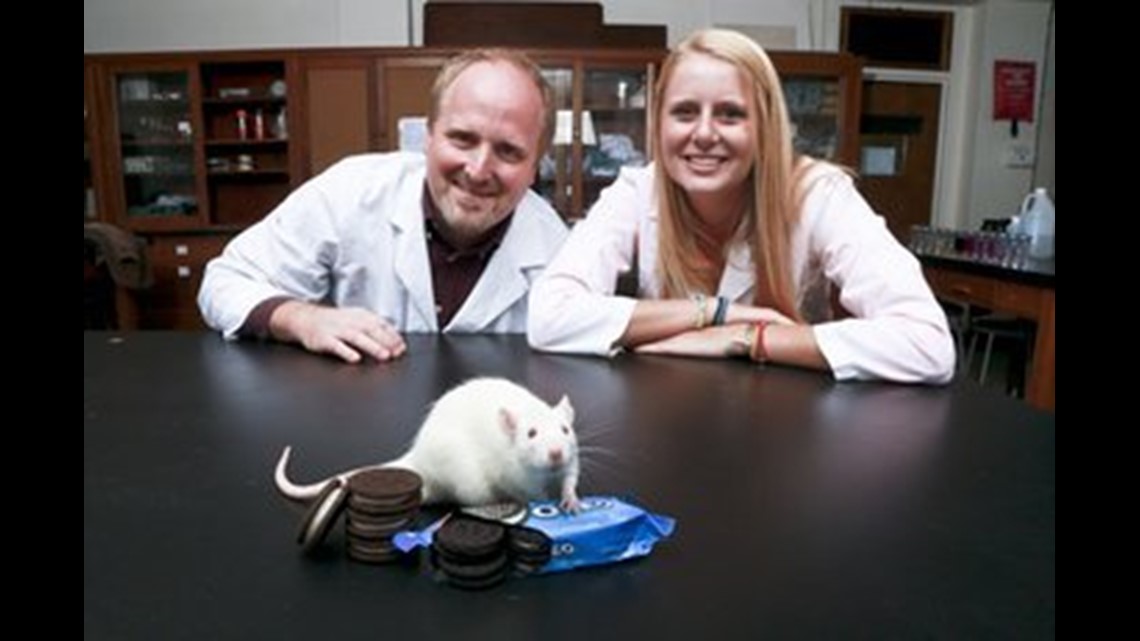NEW LONDON, Conn. (Fox CT) — Oreos may be as addictive as cocaine, at least for lab rats, according to a study done at Connecticut College.
And like most humans, rats go after the creamy center first.
In a study designed to consider the potential addictiveness of foods with high fat and high sugar content, Connecticut College Professor Joseph Schroeder and his students found eating the cookies activated more neurons in the brain’s “pleasure center” than exposure to cocaine or morphine.
They also found that rats formed an equally strong association between the pleasurable effects of eating Oreos and a specific place as they did between cocaine or morphine and a specific place.
“Our research supports the theory that high-fat, high-sugar foods stimulate the brain in the same way that drugs do,” Schroeder said. “It may explain why some people can’t resist these foods despite the fact that they know they are bad for them.”
Schroeder, an assistant professor of neuroscience, will present the research next month at the Society for Neuroscience conference in San Diego, Calif.
The research was the inspiration of neuroscience major Jamie Honohan, who undertook a project through the college’s Holleran Center for Community Action and Public Policy where students choose a social injustice and do research related to it.
Honohan, who graduated in May, was interested in the prevalence of obesity in lower socio-economic communities. “Our goal was to design a study to explore the hypothesis that high fat, high sugar foods have the same addictive potential as drugs of abuse,” Honahan said.
As for why Oreos were chosen rather than a high fat, high sugar rat chow, Schroeder said, “We specifically wanted to choose a food that was palatable to humans so that we could make a direct correlation from rats to a problem facing humans.”
Honahan said she also wanted to use a product that was common in grocery stores and, she noted, some research that showed that rats like Oreos.
The study was conducted by setting up two adjoining chambers for the rats. In one experiment, rats were given Oreo cookies in one space and rice cakes in the other. It was clear, Honahan said that the rats preferred the broken Oreos, splitting the cookies apart and devouring the cream first and then going on to eat the cookies. While they often didn’t bother to finish the rice cakes, that wasn’t the case with the Oreos.
“Just like humans, rats don’t seem to get much pleasure out of eating [rice cakes],” Schroeder said.
Then, the food was removed and the rats were given the option of spending time in either chamber. The rats spent far more time in the chamber where the Oreos had been than in the chamber where the rice cakes had been.
In a second experiment, rats were given a shot of cocaine or morphine, known addictive substances, in one chamber, while they received a shot of saline in the other. Again, the substances were removed and the rats were given the choice of which chamber to spend time in.
The research showed that the cookie-conditioned-rats chose to spend as many hours in the chamber where they had been fed Oreos, as did the drug-conditioned rats in the chambers where drugs had been injected.
In a second part of the research, Schroeder and his students measured the increased neuron activity in the part of the brain that registers pleasure.
“It basically tells us how many cells were turned on in a specific region of the brain in response to the drugs or Oreos,” Schroeder said.
The researchers found that the cookies activated significantly more neurons than cocaine or morphine.
“This correlated well with our behavioral results and lends support to the hypothesis that high-fat, high-sugar foods are addictive,” Schroeder said.
Honohan, who would like to be a physician assistant, said she hopes the research will lead to a greater understanding of how difficult it may be for people to quit eating the high-fat, high-sugar foods that can lead to obesity.
“Maybe we can approach obesity the same way we address people addicted to drugs, because neurologically, it’s the same,” she said. “Oreos and other high-fat, high-sugar foods have this potential to be just as addicting as drugs of abuse.”
Honohan said in some ways junk foods may “be more dangerous to society than drugs because you don’t have to go behind into a dark alley to buy them. You go into any grocery store or bodega and they are highly available and affordable. They target kids and families on a budget.”
As for Oreos, Honohan is done with them. She used to eat them before her research. “Now I can’t even look at them,” she said.





